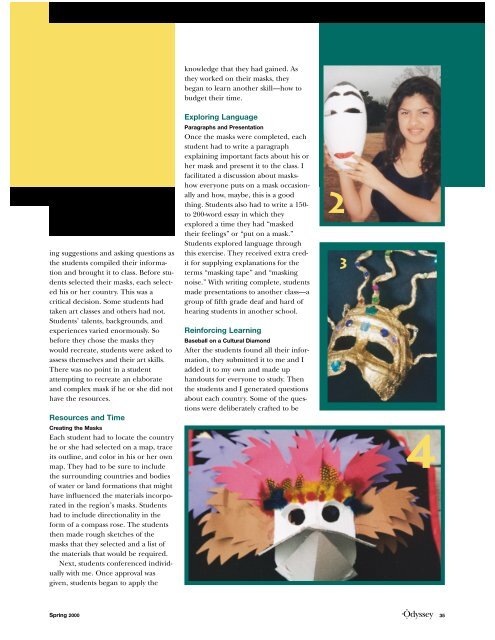Deaf ESL Students - Gallaudet University
Deaf ESL Students - Gallaudet University
Deaf ESL Students - Gallaudet University
You also want an ePaper? Increase the reach of your titles
YUMPU automatically turns print PDFs into web optimized ePapers that Google loves.
ing suggestions and asking questions as<br />
the students compiled their information<br />
and brought it to class. Before students<br />
selected their masks, each selected<br />
his or her country. This was a<br />
critical decision. Some students had<br />
taken art classes and others had not.<br />
<strong>Students</strong>’ talents, backgrounds, and<br />
experiences varied enormously. So<br />
before they chose the masks they<br />
would recreate, students were asked to<br />
assess themselves and their art skills.<br />
There was no point in a student<br />
attempting to recreate an elaborate<br />
and complex mask if he or she did not<br />
have the resources.<br />
Resources and Time<br />
Creating the Masks<br />
Each student had to locate the country<br />
he or she had selected on a map, trace<br />
its outline, and color in his or her own<br />
map. They had to be sure to include<br />
the surrounding countries and bodies<br />
of water or land formations that might<br />
have influenced the materials incorporated<br />
in the region’s masks. <strong>Students</strong><br />
had to include directionality in the<br />
form of a compass rose. The students<br />
then made rough sketches of the<br />
masks that they selected and a list of<br />
the materials that would be required.<br />
Next, students conferenced individually<br />
with me. Once approval was<br />
given, students began to apply the<br />
Spring 2000<br />
knowledge that they had gained. As<br />
they worked on their masks, they<br />
began to learn another skill—how to<br />
budget their time.<br />
Exploring Language<br />
Paragraphs and Presentation<br />
Once the masks were completed, each<br />
student had to write a paragraph<br />
explaining important facts about his or<br />
her mask and present it to the class. I<br />
facilitated a discussion about maskshow<br />
everyone puts on a mask occasionally<br />
and how, maybe, this is a good<br />
thing. <strong>Students</strong> also had to write a 150to<br />
200-word essay in which they<br />
explored a time they had “masked<br />
their feelings” or “put on a mask.”<br />
<strong>Students</strong> explored language through<br />
this exercise. They received extra credit<br />
for supplying explanations for the<br />
terms “masking tape” and “masking<br />
noise.” With writing complete, students<br />
made presentations to another class—a<br />
group of fifth grade deaf and hard of<br />
hearing students in another school.<br />
Reinforcing Learning<br />
Baseball on a Cultural Diamond<br />
After the students found all their information,<br />
they submitted it to me and I<br />
added it to my own and made up<br />
handouts for everyone to study. Then<br />
the students and I generated questions<br />
about each country. Some of the questions<br />
were deliberately crafted to be<br />
2<br />
3<br />
4<br />
35
















